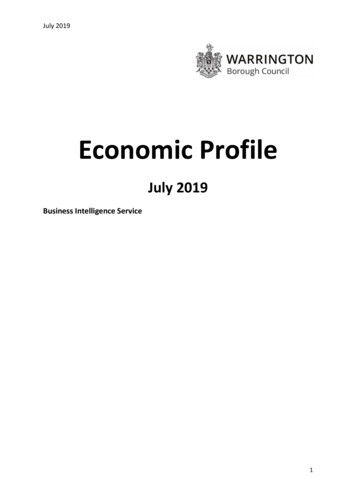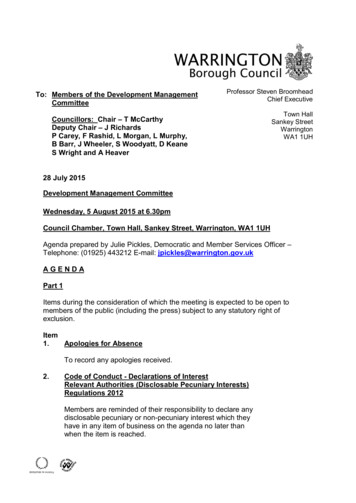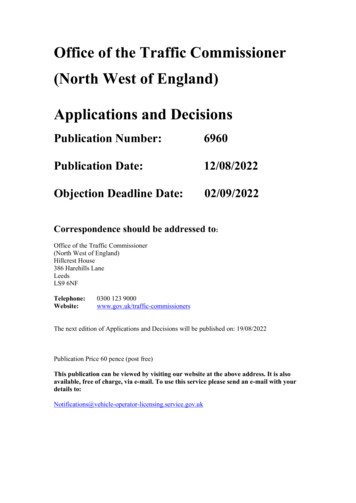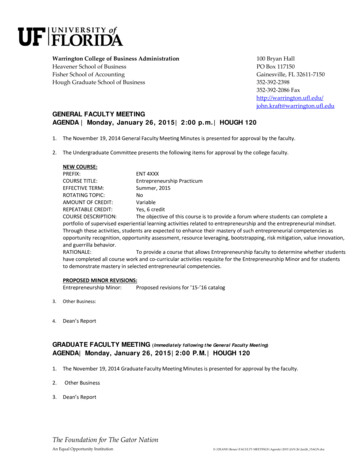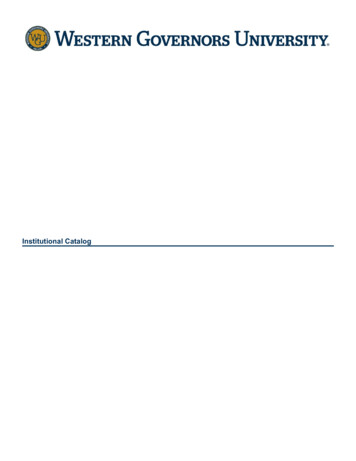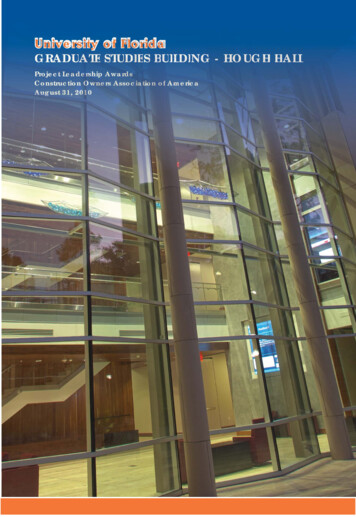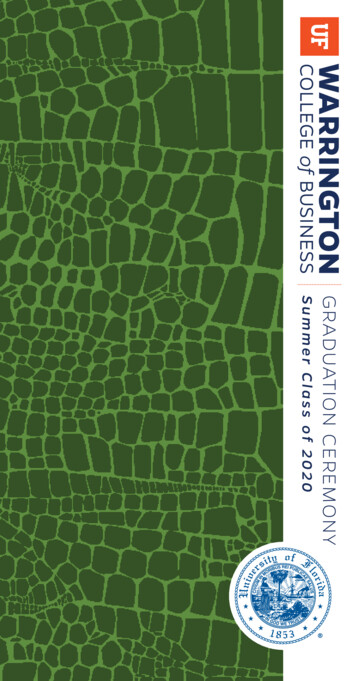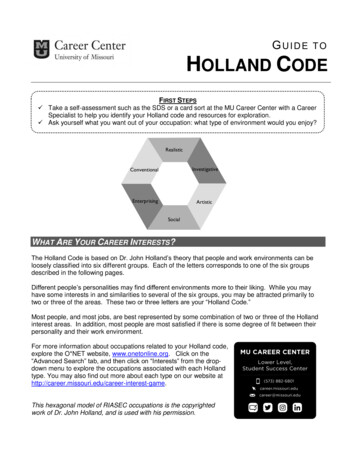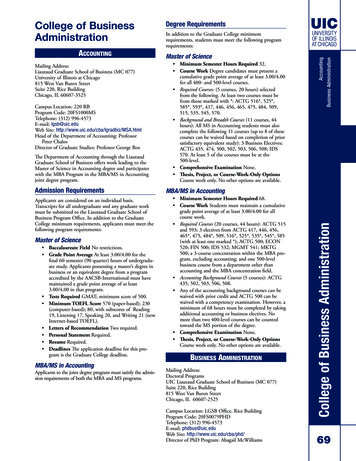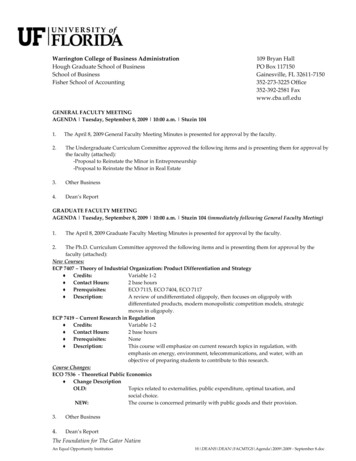
Transcription
Warrington College of Business AdministrationHough Graduate School of BusinessSchool of BusinessFisher School of Accounting109 Bryan HallPO Box 117150Gainesville, FL 32611-7150352-273-3225 Office352-392-2581 Faxwww.cba.ufl.eduGENERAL FACULTY MEETINGAGENDA Tuesday, September 8, 2009 10:00 a.m. Stuzin 1041.The April 8, 2009 General Faculty Meeting Minutes is presented for approval by the faculty.2.The Undergraduate Curriculum Committee approved the following items and is presenting them for approval bythe faculty (attached):-Proposal to Reinstate the Minor in Entrepreneurship-Proposal to Reinstate the Minor in Real Estate3.Other Business4.Dean’s ReportGRADUATE FACULTY MEETINGAGENDA Tuesday, September 8, 2009 10:00 a.m. Stuzin 104 (immediately following General Faculty Meeting)1.The April 8, 2009 Graduate Faculty Meeting Minutes is presented for approval by the faculty.2.The Ph.D. Curriculum Committee approved the following items and is presenting them for approval by thefaculty (attached):New Courses:ECP 7407 – Theory of Industrial Organization: Product Differentiation and Strategy Credits:Variable 1-2 Contact Hours:2 base hours Prerequisites:ECO 7115, ECO 7404, ECO 7117 Description:A review of undifferentiated oligopoly, then focuses on oligopoly withdifferentiated products, modern monopolistic competition models, strategicmoves in oligopoly.ECP 7419 – Current Research in Regulation Credits:Variable 1-2 Contact Hours:2 base hours Prerequisites:None Description:This course will emphasize on current research topics in regulation, withemphasis on energy, environment, telecommunications, and water, with anobjective of preparing students to contribute to this research.Course Changes:ECO 7536 - Theoretical Public Economics Change DescriptionOLD:Topics related to externalities, public expenditure, optimal taxation, andsocial choice.NEW:The course is concerned primarily with public goods and their provision.3.Other Business4.Dean’s ReportThe Foundation for The Gator NationAn Equal Opportunity InstitutionH:\DEANS\DEAN\FACMTGS\Agenda\2009\2009 - September 8.doc
Warrington College of Business AdministrationHough Graduate School of BusinessSchool of BusinessFisher School of Accounting109 Bryan HallPO Box 117150Gainesville, FL 32611-7150352-392-2397352-392-2086 Faxwww.cba.ufl.eduGENERAL FACULTY MEETINGMINUTES Wednesday, April 8, 2009 4:00 p.m. – STZ 1021.The March 5, 2009 General Faculty Meeting Minutes were presented for approval. A motion was made to approvethe minutes presented. The motion was seconded and the faculty voted to approve the minutes as distributed.2.A motion was made to approve a change in prerequisite for MAR 3023. The motion was seconded and the facultyvoted to approve the course change as presented.Course Changes (approved):MAR 3023 Change PrerequisiteCurrent:Proposed:Sophomore Standing and Completion of ECO 2023-Microeconomics or ECO 2013Macroeconomics.Sophomore Standing and completion of one of the following: ECO 2013-Macroeconomics, ECO 2023Microeconomics, or AEB 2014-Economic Issues, Food, and YouAlthough this item was presented for discussion only, the faculty agreed to suspend the by-laws temporarily in orderto vote on it. A motion was made to approve a new minor in ISOM. The motion was seconded and the faculty votedto approve the new minor in ISOM as presented.New Minor: (for discussion)(approved)Minor in Information Sciences and Operations Management5 Required Courses (12 hrs.):MAC 2233 Survey of Calculus (3 hrs.)CGS 2531 Problem Solving Using Computers (3 hrs.)ISM 4113 Business Systems Design and Applications (2 hrs.)ISM 4210 Database Management (2 hrs.)ISM 4220 Business Data Communications (2 hrs.).2 Elective Courses (4 hrs.):ISM 4330 Information Systems and Operations Strategy (2 hrs.)ISM 3254 Business Systems 1 (2 hrs.)ISM 3255 Business Systems 2 (2 hrs.)QMB 4701 Managerial Operations Analysis 1 (2 hrs.)QMB 4702 Managerial Operations Analysis 2 (2 hrs.)3.Other BusinessThere were no other business items.4.Dean’s Report-A summary of department size was shared with the faculty ranging from 2007 through 2011.th-The university should provide more information by the 15 of April on budget cuts.-The construction of Hough Hall is on schedule and expected to be ready to move in next May, 2010.-Gained 100 million on UF Campaign.A motion was made to adjourn the meeting. The motion was seconded and the meeting adjourned at 4:15 p.m.The Foundation for The Gator NationAn Equal Opportunity Institution
Page 2GRADUATE FACULTY MEETINGMINUTES Wednesday, April 8, 2009 (immediately following the General Faculty Mtg) – STZ 1021.The March 5, 2009 Graduate Faculty Meeting Minutes were presented for approval. A motion was made to approvethe minutes presented. The motion was seconded and the faculty voted to approve the minutes as distributed.2.Other BusinessThere were no other business items.3.Dean’s ReportThere was no dean’s report at the graduate faculty meeting.A motion was made to adjourn the graduate faculty meeting. The motion was seconded and the meeting adjourned at4:20 p.m.Attendees: John Kraft, Andy McCollough, Jane Douglas, Jonathan Hamilton, M. Nimalendran, Asoo Vakharia, Selcuk Erenguc, Brian Ray, Richard Lutz,Chris Janiszewski, Ginny Maurer, Bill Rossi, Alan Sawyer, Sanford BergH:\DEANS\DEAN\FACMTGS\WORKINGFOLDER\Sept 8 2009\2 2009 - April 8.doc
Warrington College of Business AdministrationSchool of Business267 Stuzin HallPO Box 117160Gainesville, FL 32611-7160352-273-0165352-846-0186 FaxAugust 26, 2009MEMORANDUMTo:Sharon HaughtonFrom:Brian RaySubject:Proposal to Reinstate the Minors in Entrepreneurship and Real EstateThe following proposals were approved by an e-mail vote of the UndergraduateCommittee. Please include these proposals on the agenda for the September 8thfaculty meeting.Reinstatement of the Entrepreneurship MinorThe entrepreneurship minor provides all undergraduates with the opportunity to learnthe basic principles of business operations and new venture development. To declarethe minor, students must complete ACG 2021C and GEB 3113 with grades of B orbetter. To complete the minor, students must:Earn an overall minimum 2.5 GPA in the minor.Take all courses for the minor for a letter grade (i.e., not pass/fail).Take all upper-division courses for the minor at the University of Florida.Course RequirementsACG 2021C Introduction to Financial Accounting (4 credits)GEB 3113 Principles of Entrepreneurship (4 credits)FIN 3403 Business Finance OR MAR 3023 Principles of Marketing (4 credits)Take Two of the Following (5-7 credits)AEB 3341 Selling Strategically (3 credits)Any Upper-level Entrepreneurship Courses Beyond GEB 3113 (2-4 credits)The Foundation for The Gator NationAn Equal Opportunity Institution
Reinstatement of the Real Estate MinorThe real estate minor provides all undergraduates with a comprehensive exposure tothe diverse field of real estate. To declare the minor, students must earn a grade of Bor better in RE 3043 Real Estate Analysis. To complete the minor, students must:Earn an overall minimum 3.0 GPA in the minor.Take all courses for the minor for a letter grade (i.e., not pass/fail).Take all upper-division courses for the minor at the University of Florida.Course RequirementsECO 2013 Principles of Macroeconomics or ECO 2023 Principles of Microeconomics (4credits)BUL 4310 The Legal Environment of Business (4 credits)REE 3043 Real Estate Analysis (4 credits)REE 4303 Real Estate Investment Decision Making (4 credits)Completion of Two of the Following Elective Courses (6-7 credits)- BCN 1210 Construction Materials- BCN 1252C Construction Drawing- BCN 1582 International Sustainable Development- BCN 3012 History of Construction- BCN 4023 Creating Affordable Housing- BCN 4751C Project Planning and Feasibility- GEO 3602 Urban and Business Geography- GEO 4620 Business Geography Integrating Theory- GIS 3043 Foundations of Geographical Information Systems- URP 2931 Seminar in Urban and Regional Issues- URP 4000 Preview of Urban and Regional Planning- URP 4273 Survey of Planning Information Systems
EconomicsProduct DifferentiationFall 2008J. HamiltonTheory of Industrial Organization:Product Differentiation and StrategyThis is the first of a four-course sequence of half-semester courses on the economics ofindustrial organization. This course begins with a review of undifferentiated oligopoly,and then focuses on oligopoly with differentiated products, modern monopolisticcompetition models, strategic moves in oligopoly, and some other topics as time permits.The focus is to prepare you to do research in industrial organization.The reading list is more extensive than what we will actually cover; it is intended to serveas a reference guide for your future work and as a general bibliography. At the beginningof each section, I will announce which articles you will be responsible for.Prerequisites If you have not taken Micro Theory (ECO 7115), Game Theory (ECO7404), and the Spring 2007 Markets (ECO 7117) class, discuss your preparation with me.RequirementsProblem sets: There will be approximately one every two weeks. They are important forlearning the material, but do not count heavily toward your grade. Some problemsets extend a lecture presentation, while others include detailed examples. Unlessstated otherwise, they must be handed in for grading. You may discuss theseproblems with other students, but you must turn in your own answers.Take-home final exam: This will be distributed on Thursday 9 October and dueThursday 16 October. It will consist primarily of problems. It may also include acareful analysis of a paper not covered in class. You are forbidden to discuss theexam questions with anyone other than the instructor; noncompliance will be aserious violation of academic honesty. Class will continue to meet throughThursday 16 October.Class Times Tuesdays and Thursdays 3rd and 4th periods, MAT 107Office Hours Wednesdays 9:30 am - 11:30 am or by appointmentOfficeMAT 224 (telephone 392-2999)Emailjon.hamilton@cba.ufl.edu or hamilton@ufl.edu
TextsTTirole, The Theory of Industrial Organization, MIT Press (1988)VVives, Oligopoly Pricing: Old Ideas and New Tools, MIT Press (1999)Supplementary TextsMotta, Competition Policy: Theory and Practice, Cambridge U Press (2004)Martin, Advanced Industrial Economics, 2nd edition, Blackwell (2002)Handbook of Industrial Organization, ooks/1573448XThe three volumes range for 1989 to 2007 and offer some review articles ondifferent topics.While most course material is from journal articles, these books have useful presentationsof some of the material. They also contain useful problems for practice.Abbreviations of Journal TitlesAERBellELIERIJIOJEPJETQJERANDREStudAmerican Economic ReviewBell Journal of EconomicsEconomics LettersInternational Economic ReviewInternational Journal of Industrial OrganizationJournal of Economic PerspectivesJournal of Economic TheoryQuarterly Journal of EconomicsRAND Journal of EconomicsReview of Economic StudiesSeveral of these journals are available online through www.jstor.org. Consulthttp://www.uflib.ufl.edu/ej/ for other online sources. I have a set of the main readingswhich I will make available for copying.Enrollment in this course constitutes acknowledgement of the following:1)I understand that the University of Florida expects its students to be honest in all of theiracademic work. I agree to adhere to this commitment to academic honesty and understand thatmy failure to comply with this commitment may result in disciplinary action, up to and includingexpulsion from the University.2)I will adhere to university copyright policies as found tudents requesting classroom accommodation must first register with the Dean ofStudents Office. The Dean of Students Office will provide documentation to the student who mustthen provide this documentation to the Instructor when requesting accommodation.2
Syllabus1. Review of Homogeneous Product Oligopoly; New Approachesa) Bertrand revisitedT5.3.2V4, 5Hamilton, “The Strategic Effect of Supply Guarantees: The Raincheck Game” in MarketStructure and Competition Policy: Game-Theoretic Approaches,” edited by G.Norman and J.-F. Thisse, Cambridge University Pressb) New approaches to existence and comparative staticsV1Amir, “Supermodularity and Complementarity in Economics: An Elementary Survey,”forthcoming, Southern Economic Journal2. Product Differentiationa) Horizontal and location modelsCheng, “Comparing Bertrand and Cournot Equilibria: A Geometric Approach,”RAND 16: 146-152 (1985)Vives, “On the Efficiency of Bertrand and Cournot Equilibria with ProductDifferentiation,” JET 36: 166-75 (1985)D’Aspremont, Gabszewicz, and Thisse, “On Hotelling’s ‘Stability in Competition,’”Econometrica 47: 1145-1150 (1979)T7.1.1V6Osborne and Pitchik, “Equilibrium in Hotelling’s Model of Spatial Competition,”Econometrica 55: 911-922 (1987)Von Ungern-Sternberg, “Monopolistic Competition and General Purpose Products,”REStud 55: 231-246 (1988)3
Hamilton, Thisse, and Weskamp, “Spatial Discrimination: Bertrand vs. Cournot in aModel of Location Choice,” Regional Science and Urban Economics19: 87-102 (1989)b) Vertical differentiation modelsT7.5.1Shaked and Sutton, “Relaxing Price Competition Through Product Differentiation,”REStud 49: 3-13 (1982)Shaked and Sutton, “Natural Oligopolies,” Econometrica 51: 1469-1484(1983)Aoki and Prusa, “Sequential versus Simultaneous Choice with Endogenous Quality,”IJIO 15:103-121 (1996)Vogel, “Spatial Competition with Heterogeneous Firms,” JPE 116: 423-466 (2008)c) Monopolistic competition modelsT7.5.2Dixit and Stiglitz, “Monopolistic Competition and Optimum Product Diversity,” AER,67: 297-308 (1977)Spence, “Product Selection, Fixed Costs, and Monopolistic Competition,” REStud 43:217-235 (1976)Ottaviano, Tabuchi, and Thisse, “Agglomeration and Trade Revisited,” IER 43: 490-435(2002)Anderson, de Palma, and Thisse, “Demand for Differentiated Products, Discrete ChoiceModels, and the Characteristics Approach,” RE Stud 56: 21-35 (1989)Anderson, de Palma, and Thisse, Discrete Choice Theory of Product Differentiation,MIT Press, 1992Haile, Hortacsu, and Kosenok, “On the Empirical Content of Quantal ResponseEquilibrium Models,” AER 98: 180-200 (2008)Anderson, de Palma, and Nesterov, “Oligopolistic Competition and the Optimal Provisionof Products,” Econometrica 63: 1281-1301 (1995)Mankiw and Whinston, “Free Entry and Social Inefficiency,” RAND 17: 48-58 (1986)4
3. Dynamic Price CompetitionStigler, “A Theory of Oligopoly,” JPE 72: 44-61 (1964)Friedman, Oligopoly and the Theory of Games, Elsevier (1977)Green and Porter, “Noncooperative Collusion under Imperfect Price Information,”Econometrica 52: 87-100 (1984)Rotemberg and Saloner, “A Supergame-Theoretic Model of Price Wars during Booms,”AER 76: 390-407 (1986)4. Entry and Exit, Strategic Moves, Raising Rivals’ CostsT8a)Contestability: an unsuccessful modelBaumol, “Contestable Markets: An Uprising in the Theory of IndustryStructure,” AER 72: 1-15 (1982)Weitzman, “Contestable Markets: An Uprising in the Theory ofIndustry Structure: Comment,” AER 73: 486-487 (1983)Schwartz and Reynolds, “Contestable Markets: An Uprising in the Theory ofIndustry Structure: Comment,” AER 73: 488-490 (1983)Baumol, Panzar, and Willig, “Contestable Markets: An Uprising in the Theoryof Industry Structure: Reply,” AER 73: 491-496 (1983)b) Commitment modelsV7.4Bulow, Geanakoplos, and Klemperer, “Multimarket Oligopoly: Strategic Substitutes andComplements, JPE 93: 488-511 (1983)Brander and Spencer, “Strategic Commitment with R&D: The Symmetric Case,”Bell 14: 225-235 (1983)c) Facilitating practices; pricing policiesCooper, “Most-favored-customer Pricing and Tacit Collusion,” RAND 17: 377-388(1986)5
d)Switching costsKlemperer, “Markets with Consumer Switching Costs,” QJE 102: 375-394 (1987)Klemperer, “The Competitiveness of Markets with Switching Costs,” RAND 18: 138150 (1987)Klemperer, “Competition when Consumers Have Switching Costs: An Overview withApplications to Industrial Organization, Macroeconomics, and InternationalTrade,” REStud 62: 515-539 (1995)e) MergersSalant, Switzer, and Reynolds, “Losses from Horizontal Merger: The Effect of anExogenous Change in Industry Structure on Cournot -Nash Equilibrium,” QJE,98(2), 185-199 (1983)Farrell and Shapiro “Horizontal Mergers: An Equilibrium Analysis,” AER 80: 107-126(1990)Deneckere and Davidson, “Incentives to Form Coalitions with Bertrand Competition,”RAND 16: 473-486 (1985)Baye, Crocker, and Ju, “Divisionalization, Franchising, and Divestiture Incentives inOligopoly,” AER 86: 223-236 (1996)e) Entry preventionMotta, 7.3Judd, “Credible Spatial Preemption,” RAND 16: 153-166 (1985)Nalebuff, “Bundling as an Entry Barrier,” QJE 119: 159-187Anderson and Engers “Preemptive Entry in Spatially Differentiated Markets,” EconomicTheory 17: 419-445 (2001)5. R&D: competition and monopolyT106
6. Two-sided marketsEvans and Schmalensee, “The Industrial Organization of Markets with Two-SidedPlatforms,” NBER Working Paper 11603 (2005)Wright, “One-sided Logic in Two-Sided Markets,” Review of Network Economics 3:44-64 (2004)Armstrong, “Competition in Two-sided Markets,” RAND 37: 668-691 (2006)Armstrong and Wright, “Two-sided Markets, Competitive Bottlenecks and ExclusiveContracts”, Economic Theory 32: 353-380 (2007)7
THE UNIVERSITY OF FLORIDADr. Mark JamisonSpring 2009Current Research in RegulationThis course will emphasize on current research topics in regulation, with emphasis onenergy, environment, telecommunications, and water, with an objective of preparingstudents to contribute to this research. In some instances we will analyze the historicliterature so that students have adequate foundation for current research themes. The classwill be taught primarily through lecture and discussion, with exercises and examsemphasizing extensions to the literature.The class will meet from 11:45 am to 1:40 pm on Tuesdays and Thursdays in Matherly51. The class begins on March 3 and ends on April 21.There is no required textbook for this course, but students may find that Jean Tirole’s TheTheory of Industrial Organization provides useful background.Your grade in this course will be determined by one-third by exercises and two-thirds bythe final exam. The Final Exam is scheduled for April 30 from 10 am to 12 noon, but willbe conducted via e-mail. Students will receive the final exam via e-mail on April 21.Copies will also be handed out in class that day. Completed exams must be emailed to theinstructor no later than midnight (Eastern Standard Time) April 23.The instructor can be contacted at 392-2929 or jamisoma@ufl.edu. The instructor’s officeis 205 Matherly and his office hours are 1:40 pm to 2:40 pm, Tuesdays and Thursdays.Students requesting classroom accommodation must first register with the Dean ofStudents Office. The Dean of Students Office will provide documentation to the studentwho must then provide this documentation to the Instructor when requestingaccommodation.Course ScheduleFollowing is the schedule of topics and key papers that will be covered. Other relevantpapers are also listed. You are responsible only for reading the key papers.March 3Overview of Utility Regulation – how regulation of utilities is donePublic Utility Research Center, “Overview of Utility Regulation,”Economics Department, University of Florida, November 2004.1Draft Date: 9/1/2009
March 5Theories of Regulation – overview of positive and normative theories ofregulation, with emphasis on opportunism, capture, and division ofexpertise.Williamson, Oliver E. 1983. “Credible Commitments: Using Hostages toSupport Exchange,” The American Economic Review 73(4): 519-540.Peltzman, Sam. 1976. “Toward a More General Theory of Regulation,”Journal of Law and Economics 19(2): 211-240.Alesina, Alberto, and Guido Tabellini. 2007. “Bureaucrats or Politicians?Part I: A Single Policy Task,” The American Economic Review 97(1):169-179.Other useful references:Armstrong, Mark, Simon Cowan, and John Vickers. 1999. RegulatoryReform: Economic Analysis and British Experience. Cambridge, MA: TheMIT Press, chapter 3.Hunter, Lawson A. W., Philippe Gauvin, and David Krause. 2008.“Changing the Presumption of when to Regulate: The Rationale ofCanadian Telecommunications Reform.” Journal of Competition Law &Economics 4(3): 775–790.Laffont, Jean-Jacques. 2005. Regulation and Development. Cambridge:Cambridge University Press.Peltzman, Sam. 1971. “Pricing in Public and Private Enterprises: ElectricUtilities in the United States,” Journal of Law and Economics 14(1): 109147.Posner, Richard. 1971. “Taxation by Regulation,” Bell Journal ofEconomics 2:22-50.Posner, Richard. 1974. “Theories of Economic Regulation,” Bell Journalof Economics 5:335-358.Prendergast, Candice. 2007. “The Motivation and Bias of Bureaucrats.”The American Economic Review 97(1): 180-196.Tirole, Jean. 1977. The Theory of Industrial Organization. Cambridge,MA: The MIT Press.2Draft Date: 9/1/2009
Wallsten, Scott. 2006. “Telecommunications Regulation in U.S. States:Its Rise and Impacts in the Early Twentieth Century,” AEI-BrookingsJoint Center for Regulatory Studies.March 17Regulatory Institutions – empirical tests of effects of regulation oninvestment, and on effects of politics on regulatory policiesHenisz, W. J. & B. A. Zelner. 2001. “The Institutional Environment forTelecommunications Investment.” Journal of Economics & ManagementStrategy, 10(1): 123-47.Gasmi, Farid, and Paul Naumba. 2006. “Political Accountability andRegulatory Performance in Infrastructure Industries: An EmpiricalAnalysis,” World Bank Policy Research Working Paper 4101.Other useful /henisz/papers.htmBrown, Keith, and Adam Candeub. 2005. “What Do Bureaucrats Want:Estimating Regulator Preferences at the FCC.” Working Paper, MichiganState University Law School.Gandala, Neil, David Salantc, Leonard Waverman. 2003. “Standards inWireless Telephone Networks.” Telecommunications Policy 27: 325–332.Gutierrez, Luis H. 2003.”The Effect of Endogenous Regulation onTelecommunications Expansion in Latin America,” Journal of RegulatoryEconomics 23(3): 257-286.Guthrie, Graeme. 2006. “Regulating Infrastructure: The Impact on Riskand Investment.” Journal of Economic Literature 64: 925–972.Hausman, William J. and John L. Neufeld. 2002. “The Market for Capitaland the Origins of State Regulation of Electric Utilities in the UnitedStates,” The Journal of Economic History 62(2): 1050-1072.Henisz, W.J. 2000. “The Institutional Environment for EconomicGrowth,” Economics and Politics 12(1): 1-31.Henisz, W. J. 2002. “The Institutional Environment for InfrastructureInvestment.” Industrial and Corporate Change, 11(2): 355-89.3Draft Date: 9/1/2009
Kosnik, Lea-Rachel D. 2005. “Entering the Fray: Interest Groups andRegulatory Battle Choice,” Department of Economics, University ofMissouri - St. Louis.Kosnik, Lea-Rachel D. 2005. “Sources of Bureaucratic Delay: A CaseStudy of FERC Dam Relicensing,” Department of Economics, Universityof Missouri - St. Louis.Wallsten, Scott J. 2001. “An econometric analysis of telecom competition,privatization, and regulation in Africa and Latin America,” The Journal ofIndustrial Economics 49(1): 1-19.Wallsten, Scott J. 2001. “Telecommunications Investment and Traffic inDeveloping Countries: The Effects of International Settlement RateReforms,” Journal of Regulatory Economics 20(3): 307-323.Wallsten, Scott. 2005. “Regulation and Internet Use in DevelopingCountries,” Economic Development and Cultural Change 53(2): 501-523.March 19Empirical Tests of CompetitionGreenstein, Shane and Michael Mazzeo. 2006. “The Role ofDifferentiation Strategy in Local Telecommunications Entry and MarketEvolution: 1999-2002,” Journal of Industrial Economics 54(3): 323-350.Bushnell, James B., Erin T. Mansur, and Celeste Saravia. 2008. “VerticalArrangements, Market Structure, and Competition: An Analysis ofRestructured US Electricity Markets.” American Economic Review 98(1):237–266.Other useful references:Amundsen, Eirik, S. and Lars Bergman. 2006. “Why has the Nordicelectricity market worked so well?” Utilities Policy 14(3): 148-157.Bajari, Patrick and Jeremy T. Fox. 2005. “Complementarities andCollusion in an FCC Spectrum Auction,” University of Michigan andNBER University of Chicago.Bushnell, James, Erin T. Mansur, and Celeste Saravia. 2005. “VerticalArrangements, Market Structure, and Competition: An Analysis ofRestructured U.S. Electricity Markets.”4Draft Date: 9/1/2009
Jamison, Mark A. 2004. “Effects of Prices for Local NetworkInterconnection on Market Structure in the U.S.” In Global Economy andDigital Society, ed. Erik Bohlin, Stanford L. Levin, Nakil Sung, andChang-Ho Yoon, 301-20. Amsterdam: Elsevier Science.Kamerschen, David R. Peter G. Klein, and David V. Porter. 2005. “MarketStructure in the US Electricity Industry: A Long-term Perspective,”Energy Economics 27: 731– 751.Li, Yan. 2008. “Econometric Evidence on the Impacts of Privatization,New Entry, and Independent Industry Regulator on Mobile NetworkPenetration and Expansion.” ESRC Centre for Competition Policy,University of East Anglia, Working Paper 08-35.Littlechild, Stephen. 2006. “Competition and contracts in the Nordicresidential electricity markets,” Utilities Policy 14(3):135-147.Quast, Troy. 2005. “An Analysis of the Extent and the Means of Entryinto Local Telecommunications Markets,” Department of Economics,University of Florida.Wallsten, Scott J. 2004. “Privatizing Monopolies in Developing Countries:The Real Effects of Exclusivity Periods in Telecommunications,” Journalof Regulatory Economics 26(3): 303-320.Wallsten, Scott. 2006. “Broadband and Unbundling Regulations in OECDCountries,” AEI-Brookings Joint Center for Regulatory Studies.Ward, Michael R. 1999. “Product Substitutability and Competition inLong Distance Telecommunications,” Economic Inquiry 37(4): 657-677.Ward, Michael R. and Glen Woroch. 2005. “Fixed-Mobile TelephoneSubscription Substitution in the U.S.” Department of Economics,University of Texas at Arlington.March 24Ownership and Governance – private versus public ownership,including franchising and forms of private participation, but emphasizingempirical tests of privatizationRose, Nancy L., and Paul L. Joskow. 1990. “The Diffusion of NewTechnologies: Evidence from the Electric Utility Industry,” The RANDJournal of Economics, 21(3): 354-373.Estache, Antonio. 2006. “PPI Partnerships vs. PPI Divorces in LDCs.”Review of Industrial Organization 29:3–26.5Draft Date: 9/1/2009
Other useful references:Arango, Santiago, Isaac Dyner and Erik R. Larsen. 2006. “Lessons fromDeregulation: Understanding Electricity Markets in South America,”Utilities Policy 14(3): 196-207.Gassner, Katharina, Alexander Popov, and Nataliya Pushak. 2008. “AnEmpirical Assessment of Private Sector Participation in Electricity andWater Distribution in Developing and Transition Economies,” WorldBank Working Paper.Newbery, David M. 2004. “Privatising Network Industries,” CESifoWorking Paper No. 1132, CESifo Working Paper Series, CambridgeUniversity.Zhang, Yin-Fang, David Parker, and Colin Kirkpatrick. (undated)“Assessing the Effects of Privatisation, Competition and Regulation onEconomic Performance: The Case of Electricity Sector Reform,” SCAPEPolicy Research Working Paper Series from National University ofSingapore, Department of Economics.March 26Direct and Indirect Network Effects – Theories of network effects andempirical testsKatz, Michael L., and Carl Shapiro. 1985. “Network Externalities,Competition, and Compatibility,” The American Economic Review 75(3):424-440.Rohlfs, Jeffrey. 1974. “A Theory of Interdependent Demand for aCommunications Service,” The Bell Journal of Economics andManagement Science, 5(1): 16-37.Cabral, Luis M. B. 2008. “Dynamic Price Competition with NetworkEffects.” New York University and Centre for Economic Policy ResearchDiscussion Paper No. 6687.Other useful references:Arora, Ashish, Christopher M. Forman, and William B. Vogt. (undated)“Complementarity in IT adoption: The Internet and LANs,” Heinz Schoolof Public Policy & Management, Tepper School of Business, and NBERCarnegie Mellon University.6Draft Date: 9/1/2009
Birke, Daniel. 2008. “The Economics of Networks: A survey of theEmpirical Literature.” Nottingham University Business School, WorkingPaper 2008-22.Cho, Kawon. 2005. “Effects of Consumer Tastes in Markets with NetworkExternalities: An Empirical Study of the Competition between IBM PCsand the Apple Macintosh,” University of Southern California.Clementsw, Matthew T. and Hiroshi Ohashiz. 2005. “Indirect NetworkEffects and the Product Cycle: Video Games in the U.S., 1994-2002,”Journal of Industrial Economics 53(4): 515-542.Doganogluy, Toker and Lukasz Grzybowski. 2005. “Estimating NetworkEffects in Mobile Telephony in Germany,” Center for Information andNetwork Economics, University of Munich.Economides, Nicholas, Matt Mitchell and Andrzej Skrzypacz. 2005.“Dynamic Oligopoly with Network Effects,” Stern School of Business,New York University.March 31Two-sided Markets, Interconnection, Network Connectivity and NetNeutrality – theories of two-sided markets and two-way interconnection,connectivity quality choices, and the issue of net neutralityArmstrong, Mark. 1998. “Network Interconnection inTelecommunications,” The Economic Journal 108(448): 545-564.Cremer, Jacques, Patrick Rey, and Jean Tirole. 2000. “Connectivity in theCommercial Internet,” The Journal of Industrial Economics 48(4): 433472.Other useful references.Dewenter, Ralf, and Jörn Kruse. 2005. “Calling Party Pays or ReceivingParty Pays? The Diffusion of Mobile Telephony with EndogenousRegulation,” Helmut-Schmidt-University Hamburg, Institute forEconomic Policy.Economides, Nicholas. 2005. “The Economics of the Internet B
Hough Graduate School of Business PO Box 117150 . School of Business Gainesville, FL 32611 -7150 Fisher School of Accounting 352-392-2397 352-392-2086 Fax www.cba.ufl.edu . GENERAL FACULTY MEETING MINUTES Wednesday, April 8, 2009 4:00 p.m. - STZ 102 . 1. The March 5, 2009 General Faculty Meeting Minutes were presented for approval.
